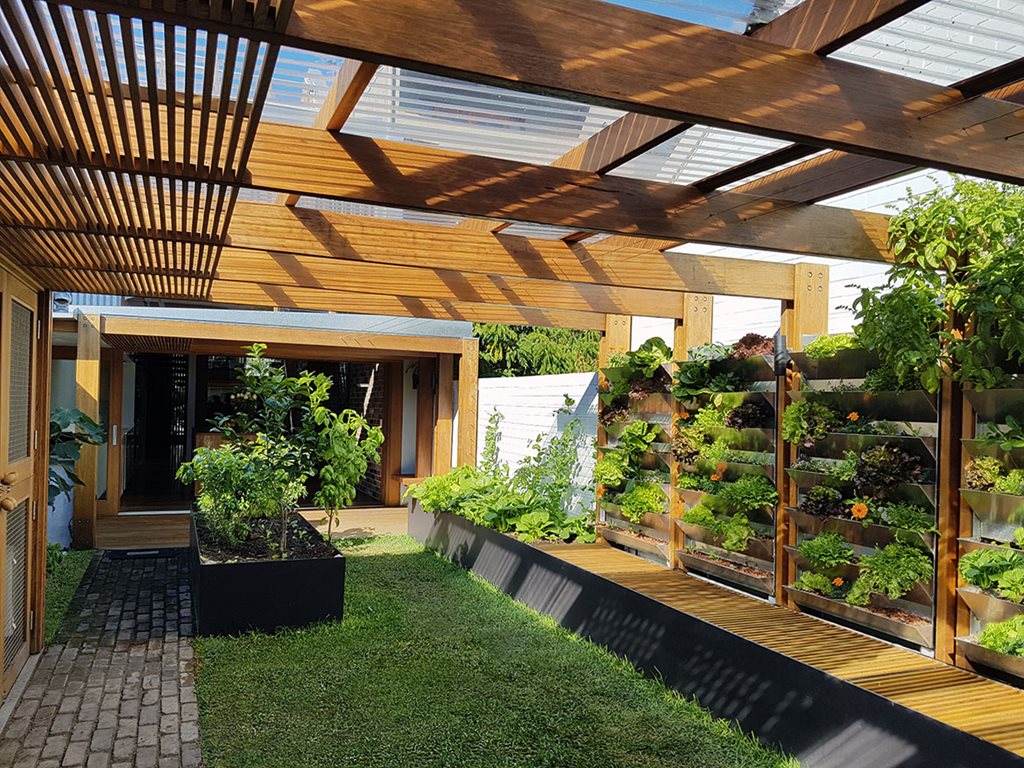
-
8 May 2017
Design and technology were used in conjunction by CplusC Architectural Workshop to enhance the environmental and social outcomes of its Alexandria Residence project.
The two-bedroom terrace house, located in Sydney’s inner west, is tightly integrated with the garden and includes an aquaponics system, rain water storage (for use throughout the home), a wicking bed, compost, productive vegetable garden, worm farm and chicken coop.
Energy use is reduced through a solar hot water system and 1.5kW photovoltaic power generation system, which could potentially charge a future electric car. In addition to its solid environmental credentials, the project’s distinctive façade has improved the couple’s community engagement as the site has become a local landmark.
As a terrace house on a tight urban site, opportunities to optimise solar orientation for passive design were somewhat limited. To increase the natural light available to the ground floor, an internal courtyard was incorporated into the design. This had a secondary benefit of improving natural ventilation and cooling throughout the house.
In addition to the passive solar design principles and well-designed thermal building envelope, energy-efficient appliances and LED lighting fixtures were selected throughout the home.
Significant research during design revealed that due to the small size of the household, a greywater system was unlikely to be cost effective. However, rainwater is used to supply non-potable uses, including in the laundry, toilets and irrigation
The clients work in energy modelling and commissioned a private report on the house a year after moving in. The overall results show that the Alexandria Residence is close to carbon neutral, predominantly due to the 1.5kW solar PV system that offsets the majority of the household electricity consumption with an 84 per cent emissions reduction.
Solar hot water also makes a significant contribution with a 17 per cent emissions reduction. The analysis also stated that the residence has reduced its water consumption by 45 per cent through rainfall harvesting which supplies the toilets, laundry and irrigation.
KEY INITIATIVES
- Aquaponics system (fish harvesting)
- Rain water storage
- Wicking bed
- Compost
- Worm farm
- Chicken coop
- Evacuated glass tube solar hot water system
- 1.5kW photovoltaic power generation system
- Permaculture principle
PRODUCTS
OPERABLE FINS
MAXIM LOUVRES
WATER TANKS
TANKMASTA BAGEL, 5000L UNDERGROUND TANK
SOLAR PANELS
1.5KW SOLAR PANELS
SOLAR EVACUATED TUBE SYSTEM
SMARTHEAT, 250L STAINLESS STEEL TANK WITH ELECTRIC BOOST
BRICKS
RECYCED BRICKS
INSULATION
SOLARTEX
SPOTTED GUM FLOORING
SE TIMBER FLOORS
WESTERN RED CEDAR WINDOWS FRAMES
WINDOOR
LIGHTING
NORTHERN LIGHTING, PLANK LIGHT POPLAR, PENDANT LIGHT 240V
Jury Citation
“It’s alive! This kind of integration of building and edible landscape is what we need to see a lot more of. The shrinking of the new building’s GFA relative to the old is a brave move by the client and the floor plan does good things for layout in its terrace context with mixed north orientation.
“With all its permaculture, aquaponics, near carbon-neutrality and its distinctive street façade, this really is both a beautiful and sustainable response to such a constrained inner-city space.”
